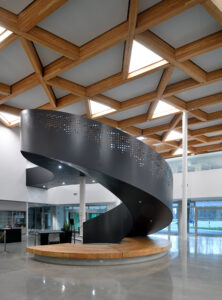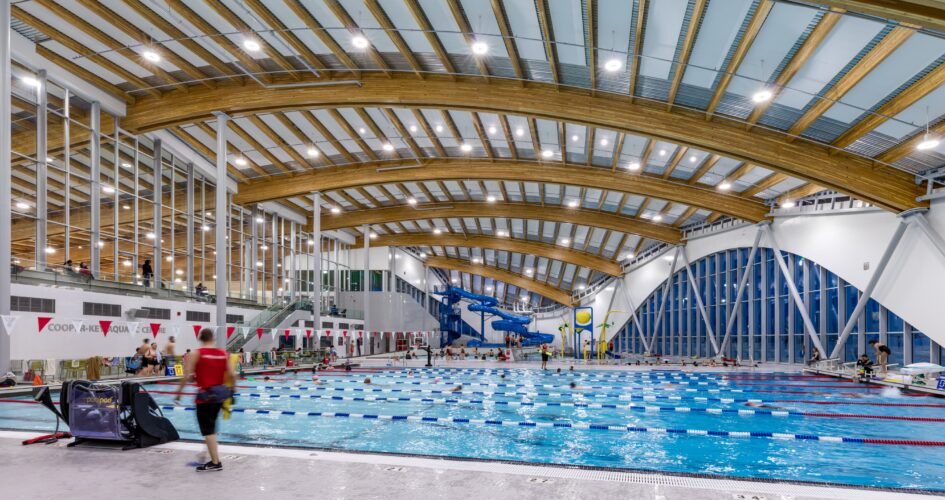Recreation and community centres are important hubs that serve many roles for an area’s residents, whether it’s playing host to weekly fitness classes, providing key social services, or acting as a shelter during an extreme weather event. Given the range of uses these large public facilities exist to fulfill, a lot goes into their planning and design.
 “Recreation centres are high-importance buildings,” explains Meredith Anderson, Principal with RJC Engineers. “From a structural perspective, they are designed for higher loads and have more stringent requirements for seismic design given they can be important spaces in the case of, say, a large earthquake. In addition, they must be welcoming and accommodating to all users in the community. Programs such as the Rick Hansen Certification provide great guidelines to ensure their design meets the highest standards for accessibility.”
“Recreation centres are high-importance buildings,” explains Meredith Anderson, Principal with RJC Engineers. “From a structural perspective, they are designed for higher loads and have more stringent requirements for seismic design given they can be important spaces in the case of, say, a large earthquake. In addition, they must be welcoming and accommodating to all users in the community. Programs such as the Rick Hansen Certification provide great guidelines to ensure their design meets the highest standards for accessibility.”
In a perfect world, there would be no budgetary limitations on a space that serves so many roles, but the reality is quite the opposite. As such, those involved in creating community centres have their work cut out for them; not only is the goal to deliver an aesthetically pleasing facility that will endure, but one that embodies community togetherness, heath and wellness, and reflects the unique history and culture of the area at large.
As Anderson puts it, “Structural systems need to respond to the needs of the building and meet the budget constraints that come with the funding models for these building types. With the continuing escalation in construction costs, it’s harder to make these projects become reality.”
And then there’s the sustainability piece—which every new building today has come to prioritize. Fortunately, wood is the material of choice for most community centres, and Anderson has a lot of love for this versatile renewable resource.
“Wood brings huge benefits to the overall carbon footprint of a building when looking at it from the perspective of the embodied carbon through a Life Cycle Assessment,” she says. “In terms of architectural intent, wood is a beautiful building material. There is an efficiency in using the building structure to express the architecture, rather than needing to cover the structure with finishes.”
Another amazing benefit of wood is its proven ability to improve the wellbeing of those that use the building. It can also be procured locally; for instance, BC has a mature timber industry and some of the most advanced mass timber production facilities in the world.
“It only makes sense to utilize these resources close to home,” Anderson concludes.
 Designing for the times
Designing for the times
In our increasingly urban environments, these community spaces are taking on a more important role than ever before, especially as dwellings become smaller and more individuals are living alone.
“Community centres are providing places for people to serve their own health and wellness needs, as well as to get out and socialize,” Anderson points out. “This means that along with dedicated spaces for sports and fitness, more flexible areas for social gatherings are becoming an important part of programming. We are also seeing multiple uses coming under the same roof, with pools, fitness rooms, arenas, and multipurpose rooms being combined with libraries, childcare, and the arts.”
Take Clayton Community Centre in Surrey, BC, for example. In addition to being the first community centre in North America to be Passive House Certified, the award-winning building is a recreation, library, arts, and parks facility all in one. According to Anderson, the architectural design features a unique pinwheel-shaped structural element that was developed for the main roof, and this form was expanded to wrap around the entire facility, showcasing wood’s beauty and versatility as a building material.
Another example is the Strathcona Gardens Recreation Centre, which is currently underway in Campbell River, BC. “In this building, a three-dimensional wood truss was developed for the long spans over the main pool areas,” she says. “The timber trusses are an important architectural feature, with hints of the mountainous surroundings in their form. The structure was designed to facilitate off-site fabrication of the trusses along with roofing and embedded mechanical services.”
For more on mass timber’s important role in the design and building of community centres, please visit rjc.ca or contact Meredith Anderson directly at: MAnderson@rjc.ca







